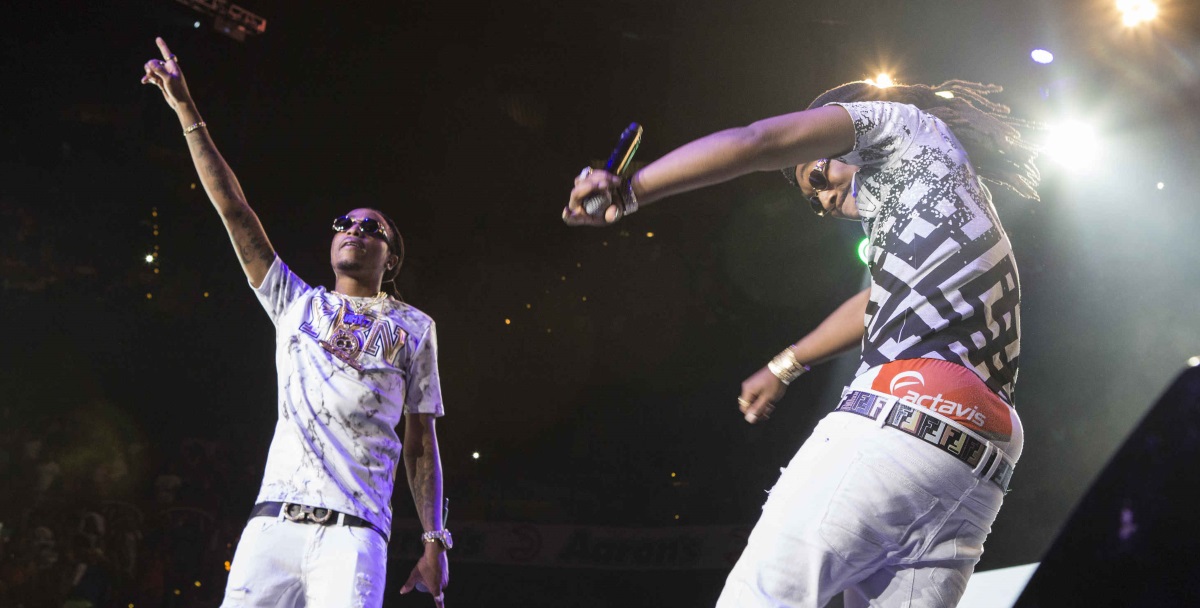From ‘Crank That’ To Dabbing: Atlanta Is A Dance Craze Mecca

At last week’s Republican debate on Fox, a few audience members pulled some dance moves. While on camera behind the moderators, they dabbed.
What is dabbing, you might ask? Let’s ask a scholar.
Hip-hop scholar Regina Bradley is a recipient of the Nasir Jones Hiphop Fellowship and is currently conducting research at Harvard University. She’s also an assistant professor of African-American Literature at Armstrong State University.
When asked the question, “What is dabbing?” she couldn’t take it too seriously.
“Dabbing is a dance that originated in Atlanta,” she said with a laugh. “It’s probably popularized because of the Migos group … And basically, you put your nose in your elbow like you’re sneezing.”
Some people link the dance craze with drug culture. A dab is a concentrated dose of marijuana made from THC extracts. Bradley argues, though, that the terms are unrelated.
There are debates over who did the first dab (the dance), but regardless, dabbing fits in a long line of dance crazes that have come out of Atlanta.
In the 90s, there was the Bankhead Bounce, but Atlanta really hit its dance craze stride during the Snap Era, the time of crunk music.
“Early 2000s, you had Lil Jon and the East Side Boyz with crunk music … it was a way to get people excited, get folks hyped, get folks crunk,” Bradley explained. “You had this explosion of different artists doing these multiple types of easy-to-do dances coming out Atlanta … Most of them had snapping in them, hence the terminology, ‘Snap Era.’”
Notably from Atlanta, there was Unk’s critical “Walk It Out,” Lil Jon and The East Side Boyz’s “Snap Your Fingers” (a literal guide to snapping), D4L’s “Laffy Taffy” and Dem Franchise Boyz’s “Lean With It Rock With It,” to name a few.
The Snap Era’s zenith was perhaps Soulja Boy’s “Crank That,” which involved a slightly more complex choreography and encouraged countrywide adaptations like the “Dora the Explorer.”
Rappers coming out of Atlanta during the Snap Era did not have to fight as hard for validation as rappers coming out in the 90s like Goodie Mob and Outkast. Atlanta was already established as a hip-hop capital.
But crunk music also had Myspace, another reason for the dance crazes’ success. Soulja Boy had millions of followers who could easily access videos of the choreography.
The Snap Era was at the cusp of the social media era, though not quite there. Video was becoming more accessible, particularly as YouTube entered the digital scene in 2005.
Today, more recent social media platforms like Snapchat, Vine and Instagram rule dance crazes. Instead of watching three to five-minute music videos, people are more likely to watch a six-second Vine.
Bradley argued that visual representations of music are more important now than they were during the Snap Era. She said that whether a dance can be turned into a meme is one factor that determines how far a dance will go.
“I really think how far it can go on social media plays a huge part now, as compared to then, about which songs make it and which songs don’t,” Bradley said. “I think what’s really interesting too is how fast something becomes viral — whether or not that is a validation of whether or not the song is good.”
With the proliferation of social media, Bradley said that dances coming out of Atlanta now, though, aren’t strictly southern.
“The Snap Era was definitely southern … the region thing is less defined in 2016 than back in the early 2000s,” Bradley said. “Now, we are looking at the dance crazes that are coming out in the South, but it’s not as important to recognize them in the South as it was previously … There isn’t such a thing as local anymore. Everything is accessible.”
From the Bankhead Bounce to the Snap Era, dances today reflect moments of youth. They are also about having fun — one reason why Bradley couldn’t define dabbing without laughing. She said, though, that having fun is an important statement for black Southern identity.
“Normally, when you think of black folks in the South, it’s like, oh so tragic,” she said. “Something that I am working on in my research is this idea that the South continues after the Civil Rights Movement. That we can have a good time. That we don’t have to be ‘politically correct’ in order to put a message out there. To suggest that being happy and having a good time is equally as important as a statement as protesting and as marching.”
9(MDAxODM0MDY4MDEyMTY4NDA3MzI3YjkzMw004))





